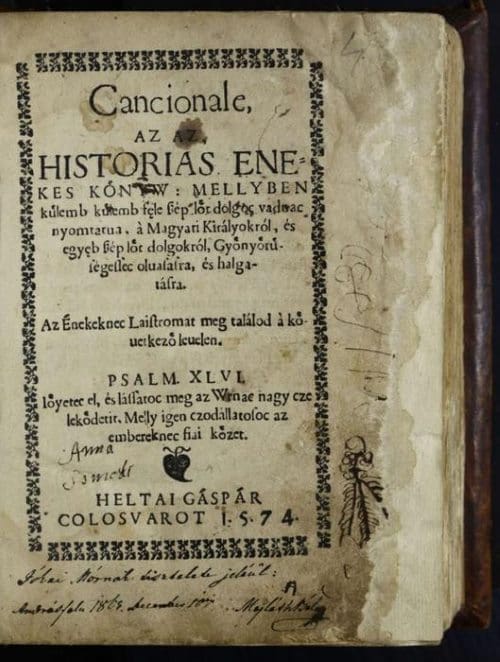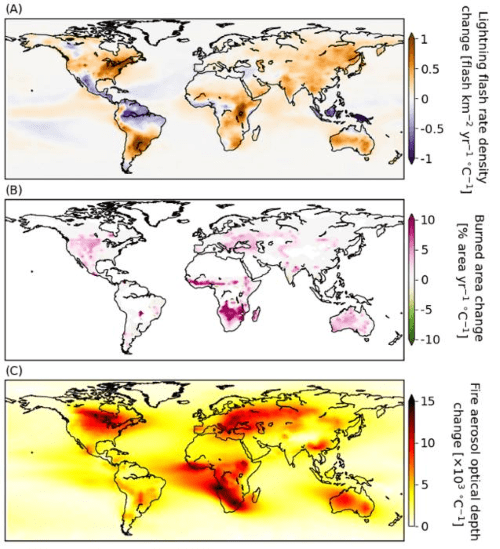Explore the latest insights from top science journals in the Muser Press daily roundup, featuring impactful research on climate change challenges.
In brief:
500-year-old Transylvanian diaries show how the Little Ice Age completely changed life and death in the region

People have been recording local climates for centuries, chronicling hot and cold periods as well as resulting floods, famines, and fatal diseases. Now, researchers have examined a wealth of historic documents to learn how climate impacted 16th century Transylvania, a region that today is part of Romania.
They found that after several decades of uncharacteristically high temperatures, the climate changed in favor of excessive rain – and that both climates shaped human lives and societies in their own way.
Glaciers, sediments, and pollen can be used to reconstruct the climate of the past. Beyond ‘nature’s archive’, other sources, such as diaries, travel notes, parish or monastery registers, and other written documents – known at the ‘society’s archive’ – contain reports and observations about local climates in bygone centuries.
Now, researchers in Romania have examined such sources to reconstruct the evolution of the climate and resulting effects on the people who lived in Transylvania in the 16th century.
“We show that the climate was marked by significant variability, including prolonged periods of drought, heatwaves, and episodes of intense rainfall and flooding,” said Tudor Caciora, a researcher at the University of Oradea and corresponding author of the Frontiers in Climate study. “The study illustrates the complex interplay between heat waves, droughts, floods, and their cascading impacts on agriculture, public health, and societal stability, emphasizing the significant role of climate in shaping human history.”
Delayed ice age
The sources tell of a particularly hot and dry first half of the century. “One compelling passage comes from a historical document describing the summer of 1540. ‘The springs dried up, and the rivers dwindled to mere trickles. Livestock fell in the fields, and the air was thick with despair as the people gathered in processions, praying for rain,” said Caciora. “This vivid account underscores the emotional and spiritual dimensions of living through climatic extremes.”
In contrast, the second half of the century was characterized by heavy rainfall and floods, particularly in the 1590s.
The western parts of the European continent cooled significantly when in the 16th century a period known as the ‘Little Ice Age’ intensified. During the second half of the century, temperatures dropped by 0.5°C. In Transylvania, however, hot weather was recorded much more frequently than cold weather during the 16th century. “This makes us believe that the Little Ice Age could have manifested itself later in this part of Europe,” said Caciora.
Later writings, in which more cold waves and severe winters are mentioned, support this thesis.
Climate catastrophes
Such weather variations often resulted in catastrophes, related directly or indirectly to the climate. These included 30 years during which the Black Death ravaged the land, 23 years or famine, and nine years during which locust invasions were recorded.

However tragic, weather extremes and resulting calamities could have driven changes in settlement patterns, the researchers said. “Towns might have adopted flood-resistant infrastructure or migrated to more favorable areas. The challenges might also have spurred technological innovations, such as improved irrigation systems or storage facilities,” Caciora explained.
The human element
“Chronicles and diaries reveal how people perceived, responded to, and were impacted by these events,” Caciora continued.
Despite the insights it provides, the study faces several limitations, the researchers pointed out. Few people were literate, reports are often subjective, or only true on local scales. In addition, the records are fragmented. For example, the researchers were not able to include any records about 15 years of the 16th century, either because no records existed, or they were too contradictory for inclusion.
Nevertheless, these writings not only provide a glimpse into how people in the past might have lived, but are also relevant for modern climate resilience strategies, particularly in understanding the socio-economic consequences of extreme weather events and their role in shaping human history.
“Studying climate records from the society’s archive is as crucial as analyzing natural proxies,” Caciora explained. “It provides a human-centric perspective on past climatic events.”
Journal Reference:
Gaceu OR, Caciora T, Baias &, Morar C, Dudaș M, Stupariu M and Maxim M, ‘Reconstruction of climatic events from the 16th century in Transylvania: interdisciplinary analysis based on historical sources’, Frontiers in Climate 6: 1507143 (2025). DOI: 10.3389/fclim.2024.1507143
Article Source:
Press Release/Material by Frontiers
The 3,000-year coral reef shutdown: a mysterious pause and a remarkable recovery
A new study led by Prof. Adi Torfstein from the Hebrew University and Prof. Oren Levy from Bar-Ilan University, in collaboration with an international team of researchers, has uncovered a significant pause in coral reef growth in the Gulf of Eilat/Aqaba, northern Red Sea, during the late Holocene period.
The findings, published in Global Change Biology, provide crucial insights into the historical resilience of coral reef ecosystems and their response to environmental shifts.

Coral reefs are vital for marine biodiversity, playing a critical role in the oceanic carbon cycle and serving as natural barriers against coastal erosion and storm surges. However, their long-term sensitivity to temperature fluctuations, sea-level shifts, and anthropogenic influences remains poorly understood.
Key Findings
- A noticeable hiatus in reef growth between 4,400 and 1,000 years Before Present (BP) was observed, coinciding with similar events recorded in Mexico, Brazil, and Australia.
- Coral diversity and abundance displayed remarkable consistency before and after the hiatus, suggesting that the reef ecosystem recovered by recolonizing from deeper coral communities.
- The study attributes this temporary “shutdown” to a combination of tectonic activity and glacio-eustatic sea-level changes. A temporary sea-level drop, possibly caused by a cooling event, exposed the reef and halted its growth.
- Additional analyses of coral skeletons in the modern era revealed a significant shift in the carbon isotopic composition, reflecting the increasing influence of human activity on the global carbon balance.
Innovative Research Methods
The research team included Dr. Bar Feldman from Bar-Ilan University, Prof. Aldo Shemesh from the Weizmann Institute, Dr. Yonathan Shaked from the Inter-University Institute of Marine Sciences (IUI), Prof. Mick O’Leary from the University of Western Australia and Prof. Huang Dunwei from the National University of Singapore, conducted extensive sampling of coral cores up to three meters long. These samples provided an unprecedented window into the growth history of the reef over the past 10,000 years.
Implications for Future Coral Conservation
Despite the historical “switch-off,” the findings highlight the resilience of coral reef ecosystems in the face of environmental challenges. However, they also underscore the pressing need for conservation efforts to address the modern threats posed by climate change, ocean acidification, and human-induced disturbances.
“Understanding how reefs have responded to past sea-level changes helps us predict their future resilience and informs conservation strategies,” said Dr. Torfstein. “While our research shows that coral communities can recover after major disruptions, today’s climate crisis presents unprecedented challenges that demand urgent action.”
Supported by the Israel Nature and Parks Authority, this study enhances our understanding of coral reef dynamics and contributes to global efforts to protect these fragile marine ecosystems.
Journal Reference:
Feldman, B., Torfstein, A., O’Leary, M., Blecher, N.S., Yam, R., Shaked, Y., Shemesh, A., Huang, D. and Levy, O., ‘Late Holocene “Turn-Off” of Coral Reef Growth in the Northern Red Sea and Implications for a Sea-Level Fall’, Global Change Biology 31: e70073 (2025). DOI: 10.1111/gcb.70073
Article Source:
Press Release/Material by The Hebrew University of Jerusalem
Unraveling the complex role of climate in dengue dynamics
The research team led by KIM Jae Kyoung, Professor in the Department of Mathematical Sciences at KAIST and Chief Investigator of the Biomedical Mathematics Group at the Institute for Basic Science (IBS), has unveiled new insights into how weather influences the spread of dengue fever. Their study identifies temperature and rainfall as critical factors driving the global surge in dengue cases and offers actionable strategies for mitigating the disease’s impact.
The study was published online in Science Advances.

Dengue fever, a mosquito-borne disease, poses an increasingly alarming public health challenge. According to the World Health Organization, reported dengue cases surged from 4.1 million in 2023 to over 10.6 million in 2024 in North and South America alone. This number represents the highest global count ever reported.
While climatic factors such as temperature and rainfall are known to drive this trend, their complex relationship with dengue dynamics remains poorly understood. Previous studies have struggled to reconcile conflicting findings – some suggest rainfall accelerates dengue transmission, while others indicate it suppresses it.
The IBS research team hypothesized that these inconsistencies stem from the limitations of traditional methods that focus on linear relationships or independent effects. To address this, the researchers utilized GOBI (General ODE-Based Inference), a novel causal inference framework that the IBS group developed in 2023. This method captures both nonlinear and combined effects of climatic factors, enabling a more nuanced analysis of the relationship between weather and dengue incidence.
The study focused on 16 regions of the Philippines, selected for their diverse climatic conditions, to examine how temperature and rainfall jointly affect dengue dynamics. There were distinct patterns of dengue regulation across the Philippines, driven by the combined effects of temperature and rainfall.
Rising temperatures were consistently associated with higher dengue incidence across all regions. On the other hand, rainfall showed contrasting effects depending on the location of the region. In eastern areas, rainfall increased dengue incidence, while in western regions, rainfall suppressed it.
The most important factor turned out to be the variation in dry season length, which was identified as critical to explaining the contrasting effects of rainfall. In regions with low variation in dry season length, rainfall tended to flush out stagnant water, reducing mosquito breeding sites and suppressing dengue transmission. On the other hand, in regions with high variation in dry season length, sporadic rainfall created new breeding sites and weakened the flushing effect, driving an increase in mosquito populations and dengue cases.
The role of dry season length has largely been overlooked in previous research but proved to be a decisive factor in this study. This discovery offers a fresh perspective on the intricate relationship between rainfall and dengue dynamics.
To validate their findings, the researchers extended their analysis to Puerto Rico, a region with distinct climatic zones. Data from municipalities including San Juan, Adjuntas, and Ponce exhibited similar regulation patterns, underscoring the generalizability of the results.
“Our findings provide robust evidence for how climatic factors influence dengue transmission in diverse environments. This represents a significant step toward understanding how climate change may impact mosquito-borne diseases globally,” said first author Olive R. CAWIDING.

The study’s findings have immediate applications for optimizing dengue intervention strategies. For low-variation regions, natural flushing effects during the rainy season may allow for scaled-back intervention efforts, freeing resources for other priorities. Specifically, consistent and year-round intervention efforts are necessary in high-variation regions to counteract the breeding-friendly conditions created by sporadic rainfall.
Furthermore, the study highlights the importance of monitoring dry season length as a predictive factor for dengue outbreaks. By tailoring strategies to specific regional climate patterns, public health agencies can allocate resources more efficiently and effectively to combat the spread of dengue.
The study represents a significant turning point in understanding how climate change impacts not only dengue fever, but also other climate-driven diseases such as malaria, influenza, and the Zika virus.
CI KIM Jae Kyoung stated: “This research is crucial as it overcomes the limitations of traditional methods for detecting nonlinear relationships and clearly elucidates the complex interactions between climatic variables and infectious diseases through an advanced causal inference algorithm. This approach can also be applied to the analysis of various diseases linked to climate.”
While the study provides robust insights, the researchers acknowledge certain limitations, including the lack of mosquito population data and socioeconomic factors such as healthcare accessibility and human mobility. Future studies with access to more granular data, such as weekly dengue incidence and mosquito dynamics, could further refine these findings.
Journal Reference:
Olive R. Cawiding, Saebom Jeon, Donnabel Tubera-Panes, Aurelio A. de los Reyes V, Jae Kyoung Kim, ‘Disentangling climate’s dual role in dengue dynamics: A multiregion causal analysis study’, Science Advances 11, eadq1901 (2025). DOI: 10.1126/sciadv.adq1901
Article Source:
Press Release/Material by Institute for Basic Science
Models show intensifying wildfires in a warming world due to changes in vegetation and humidity; only a minor role for lightning
Extreme fire seasons in recent years highlight the urgent need to better understand wildfires within the broader context of climate change. Under climate change, many drivers of wildfires are expected to change, such as the amount of carbon stored in vegetation, rainfall, and lightning strikes.

Quantifying the relative importance of these processes in recent and future wildfire trends has remained challenging, because previous climate computer model simulations did not capture the full coupling between climate change, lightning, wildfires, smoke and corresponding shifts in solar radiation and heat.
A new study published in the journal Science Advances by an international team of climate scientists presents the first realistic supercomputer simulation that resolves the complex interactions between fire, vegetation, smoke and the atmosphere.
The authors find that increasing greenhouse gas emissions will likely increase the global lightning frequency by about 1.6% per degree Celsius global warming, with regional hotspots in the eastern United States, Kenya, Uganda and Argentina. Locally this could intensify wildfire occurrences. However, the dominant drivers for the growing area burned by fires each year remain shifts in global humidity and a more rapid growth of vegetation, which can serve as wildfire fuel.
The study further identifies regions, where the intensification of fires caused by global warming will be most pronounced. Among the regions exhibiting the strongest anthropogenic trends in biomass burning are southern and central equatorial Africa, Madagascar, Australia, parts of the Mediterranean and western North-America.
“Our results show that with every degree global warming the global mean area burned by fires each year will increase by 14%. This can have substantial effects on ecosystems, infrastructure and human health and livelihoods.” says Dr. Vincent Verjans, former postdoctoral research fellow at the IBS Center for Climate Physics (now at Barcelona Supercomputing Center) and lead author of the study.
Moreover, the researchers also highlight that with more fires on a global scale, also the levels of fire smoke will increase. Smoke plumes emerging from wildfires will have an effect on air pollution and also lead to reduced penetration of sunlight. The latter changes the heat and infrared radiation in the atmosphere.
“Our new computer model simulations show for the first time that accounting for these effects in a comprehensive earth system model, can influence regional temperatures. Fire regions and their downwind smoke plume extensions will experience on average somewhat reduced warming due to the solar dimming effect.” says co-author Prof. Christian Franzke from the IBS Center for Climate Physics at Pusan National University, South Korea.
However, in addition to reducing sunlight (direct aerosol effect) which is accounted for in the new computer simulations, aerosols from biomass burning can also change the formation of clouds (indirect effect). “This part is still somewhat uncertain, and more research needs to be conducted to understand how fires will impact clouds and subsequently surface temperatures,” adds Prof. Franzke.
While this study makes important strides in representing climate-lightning-wildfire interactions in the current generation of Earth System models, it also identifies key aspects that require further consideration. A critical example is the extent to which Arctic wildfires will increase in a warmer world. In their model simulations, the increase in Arctic wildfire activity is weaker than the observed trends in recent years.
“This may indicate that current climate models underestimate future Arctic wildfire risks. Among other things, this would have important consequences for predictions of aerosols released from wildfires, which in turn will affect the climate and influence air quality,” says Dr. Vincent Verjans.
Journal Reference:
Vincent Verjans, Christian L.E. Franzke, Sun-Seon Lee, In-Won Kim, Simone Tilmes, David M. Lawrence, Franciss Vitt, and Fang Li, ‘Quantifying CO2 forcing effects on lightning, wildfires, and climate interactions’, Science Advances 11, eadt5088 (2025). DOI: 10.1126/sciadv.adt5088
Article Source:
Press Release/Material by Institute for Basic Science
Featured image credit: Gerd Altmann | Pixabay




